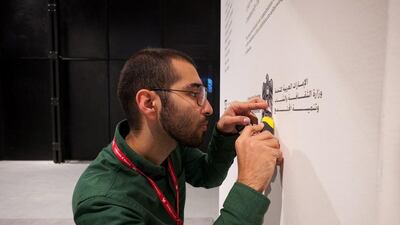To mark the ongoing 56th edition of the Venice Biennale, The Art Blog has embarked upon a project with the team of interns from the UAE who are manning the National Pavilion, currently housing the exhibition curated by Sheikha Hoor Al Qasimi: 1980 – Today: Exhibitions in the United Arab Emirates. Each intern is tasked with visiting another of the many national pavilions in Venice and bringing us back a report from the ground.
First up is Bahar Al Bahar, a Syrian architect and designer living in the UAE. Since his graduation, he has been working as a freelance designer. He feeds his urge to understand things by making, learning and traveling.
Bahar chose to write about the Mexico Pavilion: Possessing Nature:
Next to the UAE Pavilion, sharing the Sale d’Armi building in the Arsenale, is the Mexican Pavilion. This pavilion was not only the first pavilion I visited, but also one of the few pavilions that the first group of interns at the National Pavilion of the UAE were able to see come together during its construction and installation phases, while we were in parallel working behind the scenes to put together the UAE pavilion in the days leading up to the opening of the Venice Biennale.
Curated by Katla Jasso, “Possessing Nature” consists of a single site-specific installation by Mexican artists Tania Candiani and Luis Felipe Ortega. The installation draws comparisons between Venice and Mexico City: both are amphibious cities, however, while Venice has maintained its connection with water and embraced it as the theme for the city, Mexico has taken a completely different route and drained its lakes and rivers to build the city where the water once was.
The installation is made up of a series of water tanks that fill up sequentially from the water of the lagoon in the Arsenale, which is slowly pumped into a pool where a video is projected on its surface. The video projection shows scenes both from Mexico City and Venice, comparing their drainage systems. With time, the residue of the water content of small pebbles and shells accumulate on the bottom of the pool, on top of the projection, providing an element of time to the installation. At the end of the installation, a staircase takes visitors to a higher viewpoint where they can view the installation and the video projection from another perspective. The shape of the installation mirrors a trace that was drawn to connect the different places that housed the Mexican Pavilion in Venice since its inaugural participation in 2007.
From my my personal experience, going through the Mexican Pavilion had a poetic feel as I walked through it and felt the cold humid air created by the installation, and heard the sound of the flowing water, while unable to see it through the high steel tanks obstructing the view until I got to the higher viewing point.
* To read more about the Mexico Pavilion: http://mexicobienal.org/
* Keep up with Bahar Al Bahar on Instagram on @veniceinterns as well as on his personal account @b7r_b

